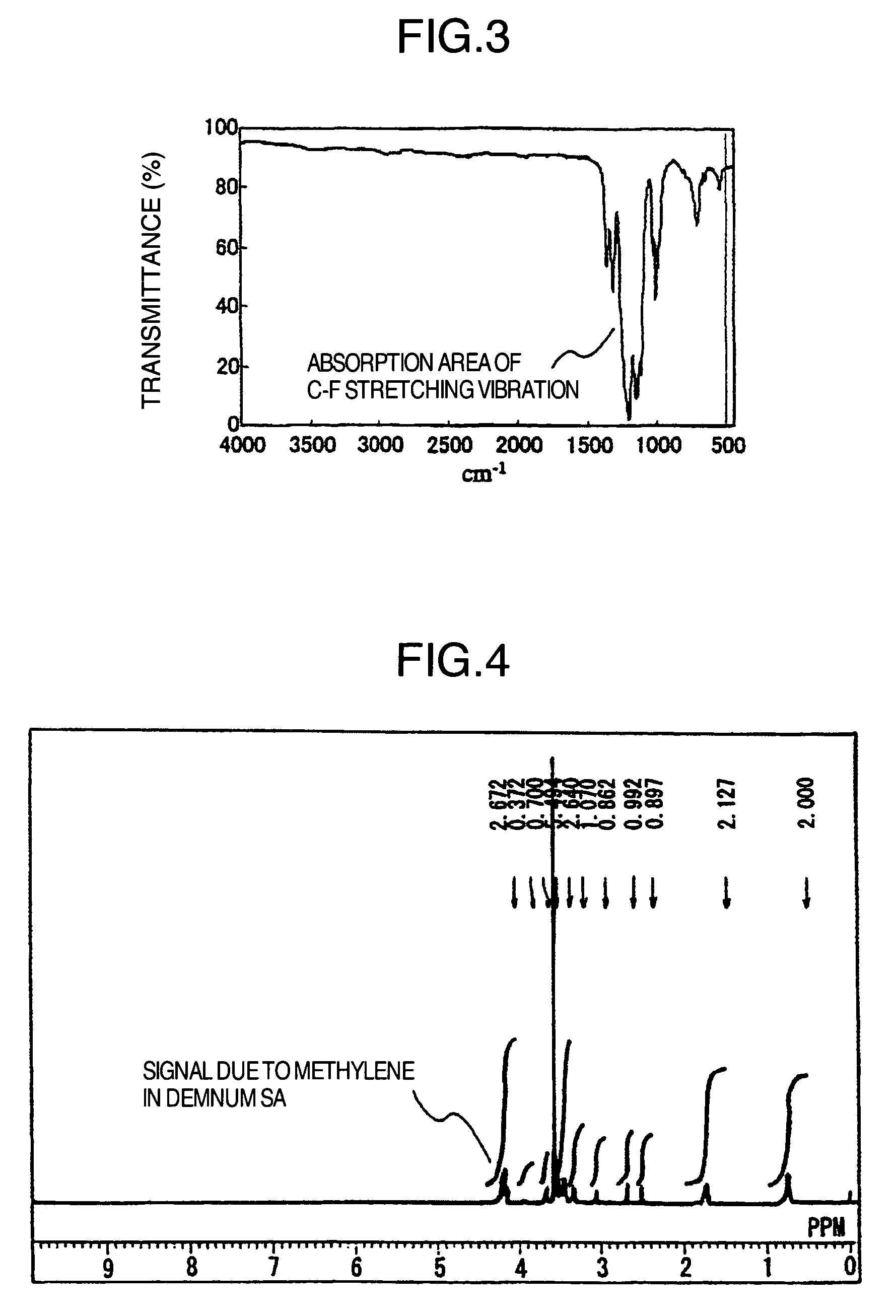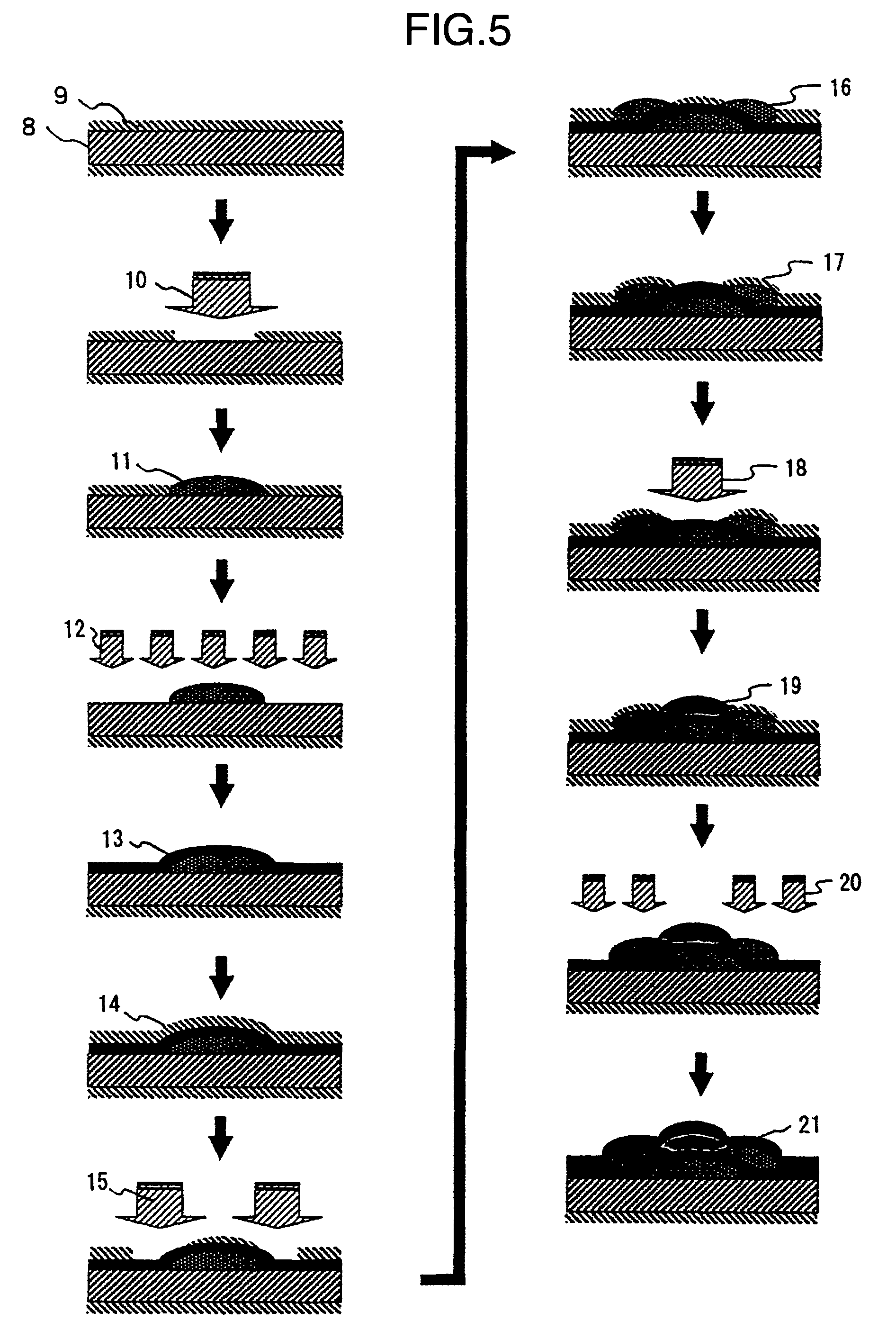Fluorine compound, liquid repellent membrane using the same and product using the same
a technology of fluorine compound and liquid repellent membrane, which is applied in the direction of conductive pattern formation, other chemical processes, instruments, etc., can solve the problems of liquid repellent membrane having a function of ph, apparatus of more sophisticated structure, and cannot be realized, and achieves the effect of little selectivity
- Summary
- Abstract
- Description
- Claims
- Application Information
AI Technical Summary
Benefits of technology
Problems solved by technology
Method used
Image
Examples
synthesis example 1
[0099] SYNTHESIS EXAMPLE 1 produced a perfluoropolyether (Compound 1, represented by the following formula) with epoxy group as X.
[0100] First, 10 parts by weight of DEMNUM SA (Daikin Kogyo, average molecular weight: 4000) and 0.1 parts by weight of DEMNUM SH (Daikin Kogyo, average molecular weight: 4000) were dissolved in 50 parts by weight of HFE-7200 (3M), to which 2 parts by weight of 3-glycidoxypropyltrimethoxysilane was added, and the mixture was stirred at 80° C. for 10 minutes. HFE-7200 was evaporated essentially totally during the stirring period. Next, the mixture was stirred at 100° C. for 4 hours, and cooled to normal temperature. The resulting residue was incorporated with 200 parts by weight of PF-5060 (3M) and 200 parts by weight of dichloromethane, and stirred. The mixture was separated into two phases in a couple of hours after it was allowed to stand. The lower phase was separated 24 hours after it was allowed to stand, and treated to remove PF-5060 as a solvent ...
synthesis example 2
[0104] SYNTHESIS EXAMPLE 2 produced a perfluoropolyether (Compound 2, represented by the following formula) with epoxy group as X.
[0105] First, 50 parts by weight of KRYTOX 157FS-L (Du Pont, average molecular weight: 2500) was dissolved in 100 parts by weight of HFE-5080 (3M), to which 2 parts by weight of lithium aluminum hydride was added, and the mixture was stirred at 80° C. for 48 hours with stirring. Then, ice water was added to the reaction solution, to separate it into two phases. The lower phase was separated, washed with 1% hydrochloric acid, and washed with water until it became neutral. It was then passed through a filter paper to remove water, and treated to remove PF-5080 by an evaporator, to produce 45 parts by weight of Compound 2′, which was KRYTOX 157FS-L with its terminal converted into CH2OH.
[0106] Then, 10 parts by weight of Compound 2′ was dissolved in 0.1 parts by weight of KRYTOX 157FS-L and 50 parts by weight of HFE-7200 (3M), to which 4 parts by weight o...
synthesis example 3
[0110] SYNTHESIS EXAMPLE 3 produced a perfluoropolyether (Compound 3, represented by the following formula) with epoxy group as X.
[0111] First, 10 parts by weight of FOMBRIN Z-DOL (Ausimont, average molecular weight: 4000) and 0.1 parts by weight of FOMBRIN Z-DIAC (Ausimont, average molecular weight: 4000) were dissolved in 50 parts by weight of HFE-7200 (3M), to which 4 parts by weight of 3-glycidoxypropyltrimethoxysilane was added, and the mixture was stirred at 80° C. for 10 minutes. HFE-7200 was evaporated essentially totally during the stirring period. Next, the mixture was stirred at 100° C. for 4 hours, and cooled to normal temperature. The resulting residue was incorporated with 1000 parts by weight of PF-5060 (3M) and 1000 parts by weight of dichloromethane, and stirred. The mixture was separated into two phases in a couple of hours after it was allowed to stand. The lower phase was separated 24 hours after it was allowed to stand, and treated to remove PF-5060 as a solve...
PUM
| Property | Measurement | Unit |
|---|---|---|
| wavelength | aaaaa | aaaaa |
| wavelength | aaaaa | aaaaa |
| wavelength | aaaaa | aaaaa |
Abstract
Description
Claims
Application Information
 Login to View More
Login to View More - R&D
- Intellectual Property
- Life Sciences
- Materials
- Tech Scout
- Unparalleled Data Quality
- Higher Quality Content
- 60% Fewer Hallucinations
Browse by: Latest US Patents, China's latest patents, Technical Efficacy Thesaurus, Application Domain, Technology Topic, Popular Technical Reports.
© 2025 PatSnap. All rights reserved.Legal|Privacy policy|Modern Slavery Act Transparency Statement|Sitemap|About US| Contact US: help@patsnap.com



